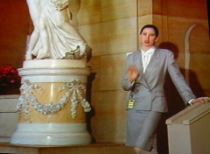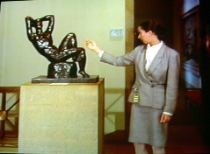 I want to encourage a trip to the cool and refreshing Philadelphia Museum of Art. Not only is the Glorious Harvest photography show glorious (see my post and Libby’s post and my PW review) but the Video Gallery has a 30 minute presentation by performance artist Andrea Fraser that’s a stitch.
I want to encourage a trip to the cool and refreshing Philadelphia Museum of Art. Not only is the Glorious Harvest photography show glorious (see my post and Libby’s post and my PW review) but the Video Gallery has a 30 minute presentation by performance artist Andrea Fraser that’s a stitch.
“Museum Highlights: A Gallery Talk” was filmed in the PMA in 1989 and the museum just bought the newly remastered work. The piece, based on Fraser’s five, live gallery tours conducted in February, 1989, is the artist’s often serious and sometimes loopy tour by a fictional character, Jane Castleton, who’s
–part Main Line Molly (prissy do-gooder with all the facts and figures at her fingertips)
–part political rally agitator haranging the audience with words about poverty and homelessness
–part satirist who — without winking — tells you about the naming rights to various PMA galleries (like the Berman Galleries where Glorious Harvest sits) and continues that “for $750,000 you could name the Museum Shop.”
The talk is very well scripted from books, pamphlets and pr material. You can almost hear the quotation marks when the artist slips from one source to another. At one point she waxes press release eloquent about Philadelphia — including its “restaurant rennaissance that the whole world’s talking about.”

There’s a welcome bench in the Video Gallery and every time I’ve been there folks feel free to pull up the floor and view from there as well. It’s a good thing because the piece is worth seeing in its entirety.
The piece’s first ten minutes are a set up and a little slow, but the fun begins after that with Fraser waxing histrionic about poverty; and mis-referencing many artworks (she points to a guard’s stool and calls it a piece of “abundance and grace;” she points to an open doorway and exit sign between galleries and says “this picture is a brilliant example of a brilliant school.” And on it goes.
Fraser’s critique of the business of museums is as fresh today as it was in 1989. Without downplaying society’s love and awe of the big repository for taste the piece raises questions about whose taste is being saved here and what that means in the long run for a world of many classes and many tastes.









